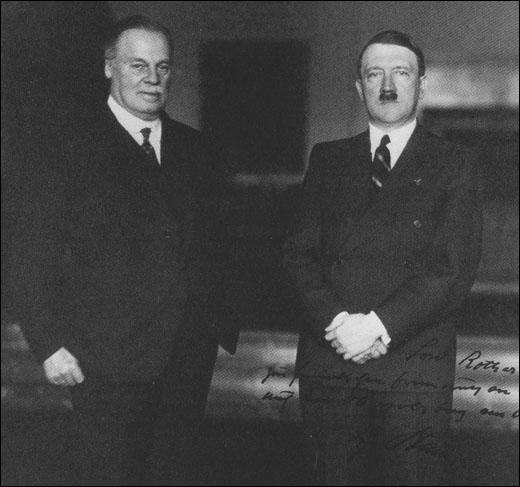On this day on 26th November
On this day in 1792 Sarah Grimké, the daughter of slaveholding judge from Charleston, South Carolina, was born. Sarah and her sister, Angelina Grimke, both developed an early dislike of slavery and after moving to Philadelphia in 1819, they joined the Society of Friends.
In 1835 Angelina Grimke had a letter against slavery published by William Lloyd Garrison, in his newspaper, The Liberator . She followed this with the pamphlet, An Appeal to the Christian Women of the South. Sarah followed her example by publishing An Epistle to the Clergy of the Southern States. These pamphlets were publicly burned by officials in South Carolina and the sisters were warned that they would be arrested if they ever returned home.
The sisters moved to New York where they became the first women to lecture for the Anti-Slavery Society. This brought attacks from religious leaders who disapproved of women speaking in public. Sarah wrote bitterly that men were attempting to "drive women from almost every sphere of moral action" and called on women "to rise from that degradation and bondage to which the faculties of our minds have been prevented from expanding to their full growth and are sometimes wholly crushed."
Refusing to give up their campaign, the sisters now became pioneers in the struggle forwomen's rights. In her book Letters on the Equality of the Sexes (1838), Grimke linked the rights of slaves to the rights of women. William Lloyd Garrison gave Grimke his support in this but Theodore Weld advised her not to "push your women's rights until human rights have gone ahead."
In 1838 Sara's sister, Angelina Grimke married Theodore Weld. Sarah moved with the couple to Belleville, New Jersey, where they opened their own school. Later they established a progressive school at the Raritan Bay Community in New York.
During the Civil War Sarah wrote and lectured in support of Abraham Lincoln. Sarah Grimké continued to work civil rights and woman's suffrage until her death on 23rd December, 1873.
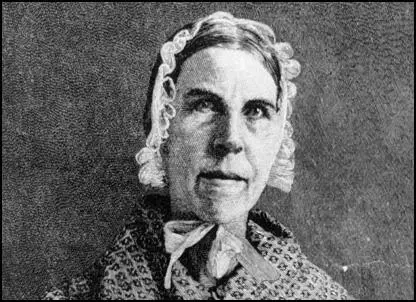
On this day in 1805 the official opening of Thomas Telford's Pontcysyllte Aqueduct.Telford, the son of a shepherd, was born in Westerkirk, Scotland in 1757. At the age of 14 he was apprenticed to a stonemason. He worked for a time in Edinburgh and in 1792 he moved to London where he was involved in building additions to Somerset House. Two years later he found work at Portsmouth dockyard.
In 1787 he became surveyor of public works for Shropshire. By this time Telford had established a good reputation as an engineer and in 1790 was given the task of building a bridge over the River Severn at Montford. This was followed by a canal that linked the ironworks and collieries of Wrexham with Chester and Shrewsbury. This involved building an aqueduct over the River Dee. On the Pontcysyllte Aqueduct, Telford used a new method of construction consisting of troughs made from cast-iron plates and fixed in masonry.
After the completion of the Ellesmere Canal Telford moved back to Scotland where he took control of the building of Caledonian Canal. Other works by Telford include the Menai Suspension Bridge (1819-1826) and the Katherine's Docks (1824-1828) in London.
Telford was also an important road builder. He was responsible for rebuilding the Shrewsbury to Holyhead road and the North Wales coast road between Chester and Bangor. During his life Telford built more than 1,000 miles of road, including the main road between London and Holyhead. Thomas Telford died in 1834.

On this day in 1883 political activist Sojourner Truth died. Originally named Isabella Baumfree, she was born a slave in Ulster County, New York State, in about 1797. At the age of nine she was auctioned off to an Englishman named John Nealey. Over the next few years she was owned by a fisherman in Kingston and then by John Dumont, a plantation owner from New York County. Between 1810 and 1827 she had five children with a fellow slave. She was dismayed when one of her sons was sold to a plantation owner in Alabama.
After New York State abolished slavery in 1827, Quaker friends helped her win back her son through the courts. She moved to New York City and obtained worked as a servant. She became friends with Elijah Pierson, a religious missionary, and eventually moved into his home.
In 1843 Isabella took the name Sojourner Truth. With the help of a white friend, Olive Gilbert, she published her book, The Narrative of Sojourner Truth. In an introduction to the book, William Lloyd Garrison wrote that he believed it would "stimulate renewed efforts to liberate all those still in slavery in America".
Over the next few years Truth toured the country making speeches on slavery. After meeting Lucretia Mott, she also spoke at meetings in favour of woman's suffrage. When a white man told her that her speeches were no more important than a fleabite, she replied, "Maybe not, but the Lord willing, I'll keep you scratching."
At the beginning of the American Civil War, she helped recruit black men to help the war effort. In 1864 she moved to Washington where she organised a campaign against the policy of not allowing blacks to sit with whites on trains. As a result of this, she was received in the White House by President Abraham Lincoln. Sojourner Truth died at Battle Creek, Michigan, on 26th November, 1883.
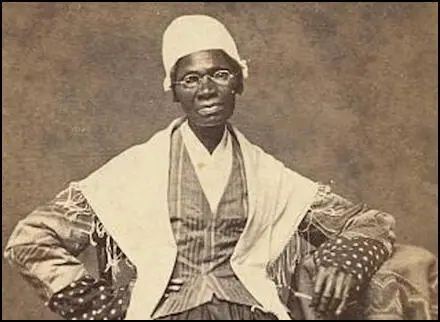
On this day in 1888 Annie Besant is elected to the London School Board in Tower Hamlets.
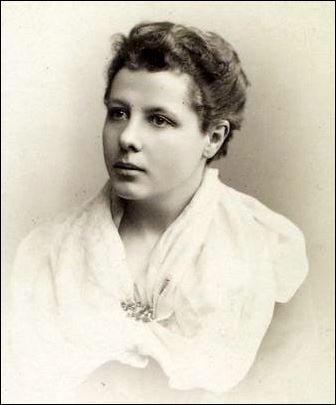
On this day in 1908 the first meeting of the Actresses' Franchise League takes place at the Criterion Restaurant at Piccadilly Circus. It had been formed by Cicely Hamilton, a member of the Women's Social and Political Union. Members included Elizabeth Robins, Kitty Marion, Winifred Mayo, Sime Seruya, Edith Craig, Inez Bensusan, Ellen Terry, Lillah McCarthy, Sybil Thorndike, Vera Holme, Lena Ashwell, Christabel Marshall, Lily Langtry and Nina Boucicault.
The Actresses' Franchise League was open to anyone involved in the theatrical profession and its aim was to work for women's enfranchisement by educational methods, selling suffrage literature and staging propaganda plays. The AFL neither supported nor condemned militancy.
Inez Bensusan oversaw the writing, collection and publication of Actress Franchise League plays. Pro-suffragette plays written by members of the Women Writers Suffrage League and performed by the Actresses' Franchise League included the play How the Vote was Won a play co-written by Christabel Marshall and Cicely Hamilton. Other popular plays included Votes for Women by Elizabeth Robins and Hamilton's A Pageant of Great Women. Membership of the AFL reached 550 by 1911.
In 1911 Edith Craig established the Pioneer Players. Under her leadership this society became internationally known for promoting women's work in the theatre. Ellen Terry was president of the Pioneer Players and Christabel Marshall contributed as dramatist, translator, actor and a member of the advisory and casting committees. One of the first productions of the group was In the Workhouse, a play written by Margaret Nevinson, one of the leaders of the Women's Freedom League (WFL). The play, based on a true story, told of how a man who used the law to keep his wife in the workhouse against her will. As a result of the play, the law was changed in 1912.
In December 1913 Inez Bensusan established the Women's Theatre Company, at the Coronet Theatre. The main objective of the organization was "to widen the sphere of propaganda still further by establishing a permanent season for the presentation of dramatic works dealing with the Women's Movement." According to Elizabeth Crawford, the author of The Suffragette Movement (1999): "It's first, and only, season was a success; its second was pre-empted by the outbreak of war."
On the outbreak of the First World War in August 1914 the AFL, at the instigation of Lena Ashwell, launched the Women's Theatre Camps Entertainments, which travelled round camps and hospitals. On 13th March 1918 the AFL took part in the victory parade organised by the National Union of Women's Suffrage Societies.
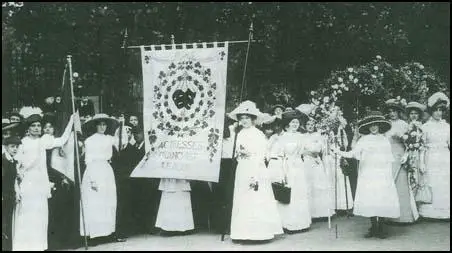
On this day in 1908 Jennie Baines and Alfred Kitson are arrested and charged with causing a riot. Baines joined up with Kitson, who was leader of the unemployed in Leeds: "Mrs Baines - perhaps not with prudence, but with the knowledge that she was within her rights - held a meeting in furtherance of the cause of Women's Suffrage outside the Coliseum at a time when Mr Asquith, the Prime Minister, was addressing a meeting inside the building. The Leeds unemployed also held a meeting in Victoria Square, and passed a resolution which authorities the defendant Kitson, who was leader of the unemployed, to go to the Coliseum and present a petition to Mr. Asquith. Having passed the resolution, the unemployed marched to the Suffragettes' meeting with the avowed object of joining forces with them. A very large crowd was thus gathered together."
At her trial in November 1908 she was the first WSPU member to be tried by jury. She was defended by Frederick Pethick-Lawrence but she was convicted of unlawful assembly outside the Coliseum in Leeds, she was sentenced to six weeks' imprisonment on refusing to be bound over because she did "not recognise the laws of this Court administered by men".
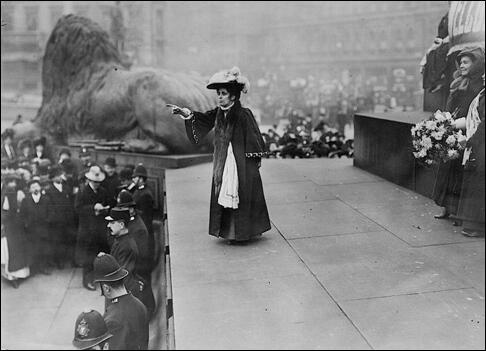
On this day in 1917 Harold Williams publishes an important article in the Daily Chronicle about the Russian Revolution. Williams began working as a journalist for The Times. He also worked for the Manchester Guardian and the Morning Post in Russia. While in the country he met Ariadna Tyrkova, a Constitutional Democrat Party member of the Duma. The couple were married in 1906.
As well as his journalistic work, Williams wrote Russia of the Russians (1914). H. G. Wells argued in the Daily News: "In a series of brilliant chapters, Doctor Williams has given as complete and balanced an account of present-day Russia as any one could desire... I could go on, sitting over this book and writing about it for days ... it is the most stimulating book upon international relations and the physical and intellectual being of a state that has been put before the English reader for many years."
On the outbreak of the First World War he was employed by the Daily Chronicle. His knowledge of the political situation was highly valued and he became an unofficial adviser to George Buchanan, the British Ambassador in Russia and Bernard Pares, British Military Observer to the Russian Army. He warned them that discontent was growing and their was a danger that the people would rebel against Tsar Nicholas II.
In February 1917, he wrote: "All attention here is concentrated on the food question, which for the moment has become unintelligible. Long queues before the bakers' shops have long been a normal feature of life in the city. Grey bread is now sold instead of white, and cakes are not baked. Crowds wander about the streets, mostly women and boys, with a sprinkling of workmen. Here and there windows are broken and a few bakers' shops looted. But, on the whole, the crowds are remarkably good-tempered and presently cheer the troops, who are patrolling the streets."
Williams interviewed Alexander Kerensky in March, 1917: "Kerensky is a young man in his early thirties, of medium height, with a slight stoop, and a quick, alert movement, with brownish hair brushed straight up, a broad forehead already lined, a sharp nose, and bright, keen eyes, with a certain puffiness in the lids due to want of sleep, and a pale, nervous face tapering sharply to the chin. His whole bearing was that of a man who could control masses. He was dressed in a grey, rather worn suit, with a pencil sticking out of his breast pocket. He greeted us with a very pleasant smile, and his manner was simplicity itself. He led us into his study, and there we talked for an hour. We discussed the situation thoroughly, and I got the impression that Kerensky was not only a convinced and enthusiastic democrat, ready to sacrifice his life if need be for democracy - that I already knew from previous acquaintance - but that he had a clear, broad perception of the difficulties and dangers of the situation, and was preparing to meet them."
Harold Williams welcomed the overthrow of Nicholas II: "It is a wonderful thing to see the birth of freedom. With freedom comes brotherhood, and in Petrograd today there is a flow of brotherly feeling. Everywhere you see it in the streets. The trams are not yet running, and people are tired of endless walking. But the habit now is to share your cab with perfect strangers. The police have gone, but the discipline is marvelous. Everyone shares the task of maintaining discipline and order. A volunteer militia has been formed and 7,000 men enrolled as special constables, mostly students, professors, and men of the professional classes generally. These, with the help of occasional small patrols of soldiers, control the traffic, guard the banks, factories, and Government buildings, and ensure security."
Williams rejected the idea that Vladimir Lenin could play an important role in affairs: "Lenin, leader of the extreme faction of the Social Democrats, arrived here on Monday night by way of Germany. His action in accepting from the German government a passage from Switzerland through Germany arouses intense indignation here. He has come back breathing fire, and demanding the immediate and unconditional conclusions of peace, civil war against the army and government, and vengeance on Kerensky and Chkheidze, whom he describes as traitors to the cause of International Socialism. At the meeting of Social Democrats yesterday his wild rant was received in dead silence, and he was vigorously attacked, not only by the more moderate Social Democrats, but by members of his own faction. Lenin was left absolutely without supporters. The sharp repulse given to this firebrand was a healthy sign of the growth of practical sense of the Socialist wing, and the generally moderate and sensible tone of the conference of provincial workers' and soldiers' deputies was another hopeful indication of the passing of the revolutionary fever."
On 8th July, 1917, Alexander Kerensky became the new leader of the Provisional Government. In the Duma he had been leader of the moderate socialists and had been seen as the champion of the working-class. Williams wrote in the Daily Chronicle: "The composition of the new government is extraordinarily moderate in the circumstances. There has been, and still is, danger from extremists, who want at once to turn Russia into a Socialist republic and have been agitating amongst soldiers, but reason has been reinforced by a sense of danger from the Germans and the lingering forces of reaction gaining the upper hand."
Williams believed that the Kornilov Revolt dramatically changed the situation and dramatically increased the influence of the Bolsheviks: "The Kornilov Affair has intensified mutual distrust and completed the work of destruction. The Government is shadowy and unreal, and what personality it had has disappeared before the menace of the Democratic Assembly. Whatever power there is again concentrated in the hands of the Soviets, and, as always happens when the Soviets secure a monopoly of power, the influence of the Bolsheviks has increased enormously. Kerensky has returned from Headquarters, but his prestige has declined, and he is not actively supported either by the right or by the left."
Alexander Kerensky was now in danger and was forced to ask the Soviets and the Red Guards to protect Petrograd. The Bolsheviks, who controlled these organizations, agreed to this request, but Lenin made clear they would be fighting against Lavr Kornilov rather than for Kerensky. Within a few days the Bolsheviks had enlisted 25,000 armed recruits to defend Petrograd. While they dug trenches and fortified the city, delegations of soldiers were sent out to talk to the advancing troops. Meetings were held and Kornilov's troops decided not to attack Petrograd. General Krymov committed suicide and Kornilov was arrested and taken into custody.
Leon Trotsky and Vladimir Lenin now urged the overthrow of the Provisional Government. On the evening of 24th October, 1917, orders were given for the Bolsheviks began to occupy the railway stations, the telephone exchange and the State Bank. The following day the Red Guards surrounded the Winter Palace. Inside was most of the country's Cabinet, although Kerensky had managed to escape from the city. The Winter Palace was defended by Cossacks, some junior army officers and the Woman's Battalion. At 9 p.m. the Aurora and the Peter and Paul Fortress began to open fire on the palace.
The attacks on the Winter Palace caused little damage but the action persuaded most of those defending the building to surrender. The Red Guards, led by Vladimir Antonov-Ovseenko, now entered the building and arrested the Cabinet ministers. Albert Rhys Williams reported: "A terrible lust lays hold of the mob - the lust that ravishing beauty incites in the long starved and long denied - the lust of loot. Even we, as spectators, are not immune to it. It burns up the last vestige of restraint and leaves one passion flaming in the veins - the passion to sack and pillage. Their eyes fall upon this treasure-trove, and their hands follow."
On 26th October, 1917, the All-Russian Congress of Soviets met and handed over power to the Soviet Council of People's Commissars. Vladimir Lenin was elected chairman and other appointments included Leon Trotsky (Foreign Affairs) Alexei Rykov (Internal Affairs), Anatoli Lunacharsky (Education), Alexandra Kollontai (Social Welfare), Felix Dzerzhinsky (Internal Affairs), Joseph Stalin (Nationalities), Peter Stuchka (Justice) and Vladimir Antonov-Ovseenko (War).
A total of 703 candidates were elected to the Constituent Assembly in November, 1917. This included Socialist Revolutionaries (299), Bolsheviks (168), Mensheviks (18) and Constitutional Democratic Party (17). The Bolsheviks were bitterly disappointed with the result as they hoped it would legitimize the October Revolution. When it opened on 5th January, 1918, Victor Chernov, leader of the Socialist Revolutionaries, was elected President. When the Assembly refused to support the programme of the new Soviet Government, the Bolsheviks walked out in protest. Later that day, Lenin announced that the Constituent Assembly had been dissolved. Soon afterwards all opposition political groups were banned in Russia.
Williams wrote in the Daily Chronicle on 26th November, 1917: "If you lived here you would feel in every bone of your body, in every fibre of your spirit, the bitterness of it... I cannot tell you all the brutalities, the fierce excesses, that are ravaging Russia from end to end and more ruthlessly than any invading army. Horrors pall on us - robbery, plunder and the cruellest forms of murder are grown a part of the very atmosphere we live in. It is worse than Tsarism ... The Bolsheviks do not profess to encourage any illusions as to their real nature. They treat the bourgeoisie of all countries with equal contempt; they glory in all violence directed against the ruling classes, they despise laws and decencies that they consider effete, they trample on the arts and refinements of life. It is nothing to them if in the throes of the great upheaval the world relapses into barbarism."
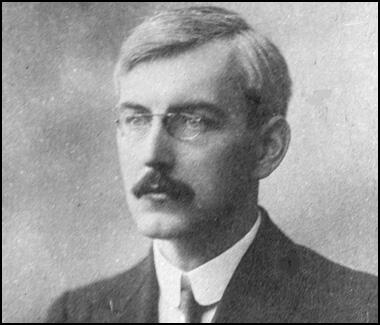
On this day in 1917 Elsie Inglis, surgeon and suffragist died. Elsie Inglis, the second daughter of John Inglis (1820–1894), who worked for the East India Company, was born at Naini Tal, in India, on 16th August 1864. When her father retired from his job in 1878 the Inglis family returned to Scotland and settled in Edinburgh.
In 1878 Elsie began her education at the Edinburgh Institution for the Education of Young Ladies and at eighteen she went to a finishing school in Paris for a year. Elsie Inglis lived a life of leisure until Sophia Jex-Blake opened the Edinburgh School of Medicine for Women in 1886. With the support of her father, she began to train as a doctor. When Dr. Jex-Blake, dismissed two students for what Inglis considered to be a trivial offence, she obtained funds from her father and some of his wealthy friends, and established a rival medical school, the Scottish Association for the Medical Education for Women. Subsequently she studied for eighteen months at the Glasgow Royal Infirmary. After completing her training she went to work for the New Hospital for Women, opened by Elizabeth Garrett Anderson in 1890.
Elsie Inglis supported women's suffrage and had joined the Central Society for Women's Suffrage while a student in Edinburgh. In 1892 she became more active in the campaign and agreed to the suggestion made by Elizabeth Wolstenholme-Elmy to make speeches on women's medical education. She also joined the National Union of Suffrage Societies during this period.
In 1894 Inglis returned to Edinburgh and set up in practice with Dr. Jessie MacGregor, who had been a fellow student at the Edinburgh School of Medicine for Women, and in 1898 opened a hall of resistance for women medical students. The following year Inglis was appointed lecturer in gynaecology at the Medical College for Women. She also opened a small hospital for women in George Square.
As Elizabeth Crawford, the author of The Suffragette Movement (1999) has pointed out: "In addition to her medical work, from 1900 she was a very active suffrage campaigner in Scotland, speaking at up to four meetings a week, travelling the length and breadth of the country.... From 1909 Elsie Inglis, who was already honorary secretary of the Edinburgh National Suffrage Society, became secretary of the newly-formed Federation of Scottish Suffrage Societies."
It has been argued by Rebecca Jennings, the author of A Lesbian History of Britain (2007), that Inglis was a lesbian and lived for many years with Flora Murray, who later had a romantic relationship with Louisa Garrett Anderson.
Inglis was a strong supporter of the National Union of Suffrage Societies strategy to obtain the vote. She joined with Elizabeth Garrett Anderson and Elizabeth Wolstenholme-Elmy in signing the letter published in Votes for Women, on 26th July 1912 that protested against the arson campaign that had been unleashed by the Women Social & Political Union.
On the outbreak of the First World War, Inglis applied to Louisa Garrett Anderson for a place in the Women's Hospital Corps, but was told that they already had enough volunteers. Inglis now suggested that women's medical units should be allowed to serve on the Western Front. However, the War Office, rebuffed with the words, "My good lady, go home and sit still." Inglis now took the idea to the Scottish Federation of Women's Suffrage Societies, which agreed to form a hospitals committee. The Common Cause, the journal of the National Union of Suffrage Societies, also published a plea for funds and she was able to establish the Scottish Women's Hospitals for Foreign Service (SWH).
As her biographer, Leah Leneman, has pointed out: "The War Office may have spurned the idea of all-women medical units, but other allies were desperate for help, and both the French and the Serbs accepted the offer. The first unit left for France in November 1914 and a second unit went to Serbia in January 1915. Inglis was torn between her desire to oversee the fund-raising and organizational side of the SWH and her desire to serve in the field, but in mid-April the chief medical officer of the first Serbian unit fell ill, and Inglis went out to replace her. During the summer she set up two further hospital units."
By 1915 the Scottish Women's Hospital Unit had established an Auxiliary Hospital with 200 beds in the 13th century Royaumont Abbey. Her team included Evelina Haverfield, Ishobel Ross and Cicely Hamilton. In April 1915 Elsie Inglis took a women's medical unit to Serbia. During an Austrian offensive in the summer of 1915, Inglis was captured but eventually, with the help of American diplomats, the British authorities were able to negotiate the release of Inglis and her medical staff.
During the First World War Inglis arranged fourteen medical units to serve in France, Serbia, Corsica, Salonika, Romania, Russia and Malta. In August 1916, the London Suffrage Society financed Inglis and eighty women to support Serbian soldiers fighting for the allies. One government official who saw the doctors and nurses working in Russia remarked that: "No wonder England is a great country if the women are like that."
Ishobel Ross recalls visiting the Balkan Front with Ingles in February 1917: "Mrs. Ingles and I went up behind the camp and through the trenches. It was so quiet with just the sound of the wind whistling through the tangles of wire. What a terrible sight it was to see the bodies half buried and all the place strewn with bullets, letter cases, gas masks, empty shells and daggers. We came across a stretch of field telephone too. It took us ages to break up the earth with our spades as the ground was so hard, but we buried as many bodies as we could. We shall have to come back to bury more as it is very tiring work."
In March 1917 Inglis had a disagreement with Evelina Haverfield. She later wrote: "I hope the Committee will realize that though Mrs. Haverfield and I differed over the plans for the future, there isn't a particle of ill-feeling between us. Mrs. Haverfield is as generous and open-minded and as ready to face facts as she always was. All we either of us care about is the success of the unit - and our ideas differ... The Committee must decide between us! - Anyhow they may be thoroughly proud of the work the Transport has accomplished."
Florence Farmborough was one of those who met her while she was serving in Podgaytsy. "There is an English hospital in Podgaytsy, run by a group of English nurses, under the leadership of an English lady-doctor (Dr. Elsie Inglis). I was very glad to chat with them in my mother-tongue and above all to learn the latest news of the allied front in France. They are very nice women, those English and Scottish nurses. They all have several years of training behind them. I feel distinctly raw in comparison, knowing that a mere six-months' course as a VAD in a military hospital would, in England, never have been considered sufficient to graduate to a Front Line Red Cross Unit."
Elsie Inglis was taken ill while in Russia and was forced to travel back to Britain. Inglis, who was suffering from cancer, arrived at Newcastle Upon Tyne on 25th November, 1917, but local doctors were unable to save her and she died the following day. Arthur Balfour, the Secretary of State for Foreign Affairs commented on her death: "Elsie Inglis was a wonderful compound of enthusiasm, strength of purpose and kindliness. In the history of this World War, alike by what she did and by the heroism, driving power and the simplicity by which she did it, Elsie Inglis has earned an everlasting place of honour."
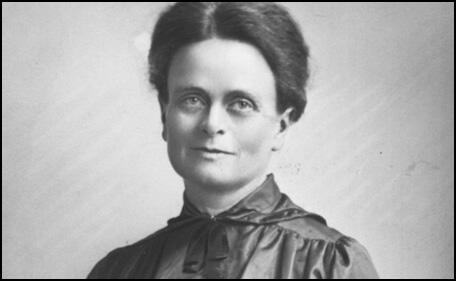
On this day in 1938 The Picture Post begins its campaign against the persecution of Jews in Nazi Germany. The magazine that pioneered photojournalism, was edited by Stefan Lorant, when it was first published in 1938 by Edward G. Hulton. The magazine was an immediate success and after four months was selling 1,350,000 copies a week.
When Lorant emigrated to the United States in 1940 Tom Hopkinson took over as editor. Hopkinson recruited a team of talented writers and photographers including Tom Winteringham, Walter Greenwood, Vernon Bartlett, A. L. Lloyd, James Cameron, Robert Kee, Ted Castle and Bert Hardy.
In the journal published on 26th November 1938, Hopkinson ran a picture story entitled Back to the Middle Ages. Photographs of Adolf Hitler, Joseph Goebbels, Herman Goering and Julius Steicher were contrasted with the faces of those scientists, writers and actors they were persecuting.
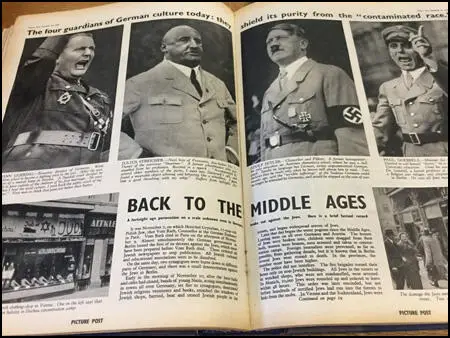
On this day in 1940 fascist supporter and press baron Lord Rothermere died In December, 1931, Lord Rothermere,had a meeting with Oswald Mosley. According to his son, Nicholas Mosley, Rothermere told him that he was prepared to put the Harmsworth press at his disposal if he succeeded in organising a disciplined Fascist movement from the remnants of the New Party. The details of this meeting was recorded in his diary by Mosley's close friend, Harold Nicolson.
It was very important to Rothermere that this new party would target working-class voters in order that it would help the fortunes of the Conservative Party. Cynthia Mosley disagreed with her husband's move to the right. According to Robert Skidelsky: "Cimmie (Cynthia) was frankly terrified of where his restlessness would lead him. She hated fascism and Harmsworth (Lord Rothermere, the press baron). She threatened to put a notice in The Times dissociating herself from Mosley's fascist tendencies. They bickered constantly in public, Cimmie emotional and confused, Mosley ponderously logical and heavily sarcastic."
The British Union of Fascists (BUF) was formally launched on 1st October, 1932. It originally had only 32 members and included several former members of the New Party: Robert Forgan, William E. Allen, John Beckett and William Joyce. Mosley told them: "We ask those who join us... to be prepared to sacrifice all, but to do so for no small or unworthy ends. We ask them to dedicate their lives to building in the country a movement of the modern age... In return we can only offer them the deep belief that they are fighting that a great land may live."
Attempts were made to keep the names of individual members a secret but supporters of the organization included Lord Rothermere, Major General John Fuller, Jorian Jenks, Commander Charles E. Hudson, Wing-Commander Louis Greig, A. K. Chesterton, David Bertram Ogilvy Freeman-Mitford (Lord Redesdale), Unity Mitford, Diana Mitford, Patrick Boyle (8th Earl of Glasgow), Malcolm Campbell and Tommy Moran. Mosley refused to publish the names or numbers of members but the press estimated a maximum number of 35,000.
Lord Rothermere also kept his promise to Oswald Mosley and gave his full support to the National Union of Fascists. He wrote an article, Hurrah for the Blackshirts, for The Daily Mail, on 22nd January, 1934, in which he praised Mosley for his "sound, commonsense, Conservative doctrine". Rothermere added: "Timid alarmists all this week have been whimpering that the rapid growth in numbers of the British Blackshirts is preparing the way for a system of rulership by means of steel whips and concentration camps. Very few of these panic-mongers have any personal knowledge of the countries that are already under Blackshirt government. The notion that a permanent reign of terror exists there has been evolved entirely from their own morbid imaginations, fed by sensational propaganda from opponents of the party now in power. As a purely British organization, the Blackshirts will respect those principles of tolerance which are traditional in British politics. They have no prejudice either of class or race. Their recruits are drawn from all social grades and every political party. Young men may join the British Union of Fascists by writing to the Headquarters, King's Road, Chelsea, London, S.W."
The Daily Mail continued to give its support to the fascists. Lord Rothermere allowed fellow member of the January Club, Sir Thomas Moore, the Conservative Party MP for Ayr Burghs, to publish pro-fascist articles in his newspaper. Moore described the BUF as being "largely derived from the Conservative Party". He added "surely there cannot be any fundamental difference of outlook between the Blackshirts and their parents, the Conservatives?" (134)
In April 1934, The Daily Mail published an article by Randolph Churchill that praised a speech that Mosley made in Leeds: "Sir Oswald's peroration was one of the most magnificent feats of oratory I have ever heard. The audience which had listened with close attention to his reasoned arguments were swept away in spontaneous reiterated bursts of applause." (135)
The problem for Rothermere was that BUF's main support came from Conservative supporting rural areas. At first Oswald Mosley devoted a high proportion of his time to speeches in market towns in agricultural counties where he "tapped into the traditional conservatism of a farming community" which had been suffering from intractable economic problems since the end of the First World War. His early campaigns pulled in several disgruntled farmers and ex-Conservatives including Viscountess Dorothy Downe, Richard Reynell Bellamy, Ronald N. Creasy and Robert Saunders. (136)
Lord Rothermere not only gave money to the the BUF but "also conceived a plan to make a fortune, for the movement and for himself, by using the party's several hundred branches as outlets to sell cigarettes that he would manufacture". Rothermere bought machinery and persuaded a manager from Imperial Tobacco to join the project and told Mosley that "one of two things is going to happen: either we're going to do a lot of business, or the tobacco companies are going to pay us a large amount of money not to do business." (137)
In July, 1934 Lord Rothermere suddenly withdrew his support for Oswald Mosley. The historian, James Pool, argues: "The rumor on Fleet Street was that the Daily Mail's Jewish advertisers had threatened to place their ads in a different paper if Rothermere continued the profascist campaign." Pool points out that sometime after this, Rothermere met with Hitler at the Berghof and told how the "Jews cut off his complete revenue from advertising" and compelled him to "toe the line." Hitler later recalled Rothermere telling him that it was "quite impossible at short notice to take any effective countermeasures." (138)
This was confirmed in 2007 by Paul Briscoe, in his biography, My Friend the Enemy: An English Boy in Nazi Germany. He tells the story of his mother Norah Briscoe, who worked for the PR department of Unilever. One of the tasks she was given was to collect all references to Sir Oswald Mosley, the leader of the National Union of Fascists, that had appeared in all the newspapers owned by Lord Rothermere. She later learned that the cuttings had been requested by some Jewish directors of Unilever.
As a result of this investigation "Jewish directors of Unilever... decided to present Harmsworth's owner, Lord Rothermere, with an ultimatum: if he did not stop backing Mosley, they and their friends would stop placing advertisements in his papers. Rothermere gave in." However, as Paul pointed out, her investigation involved her "reading almost everything favourable that had been written recently about Mosley and his Blackshirts. What she read, she liked." Norah handed in her notice at Uniliver and decided to become a pro-fascist freelance journalist. (139)
At first Mosley threatened to expose the pressure that the Jewish business community had placed on Rothermere. However, after lengthy negotiations, the Daily Mail published an exchange of friendly letters that Rothermere and Mosley had concocted between themselves to smooth the parting of the ways. "Having urged young men to join the British Union of Fascists (and printed its address) Rothermere now spelt out his aversion to fascism, dictatorship, and anti-Semitism."
This message his readership as for a long time the newspaper had been anti-Semitic in tone and after the break with Mosley the newspaper continued to support Hitler despite his terrible treatment of Jews in Nazi Germany. In an article published in June 1935, he pointed out: "After unusual opportunities of observing Herr Hitler at close range, both in private conversation and by a correspondence extending over many months, I would sum up his personality in two words. He is a practical mystic. In him is found the rare combination of dreamer and doer. Like Oliver Cromwell, Joan of Arc, and the Prophet Mahommed, he draws his inspiration from a hidden light not shared by his fellow men. Hitler is in the direct tradition of those great leaders of mankind who appear rarely more often than once in two or three centuries. He is the incarnation of the spirit of the German race."
